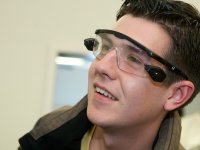6 Exciting AR Apps for Student Learning
Using augmented reality apps like Quiver, Elements 4D, and Aurasma, you can engage students with learning materials that spring to life in three-dimensional overlays.
Your content has been saved!
Go to My Saved Content.Augmented reality (AR) can serve a variety of purposes in your classroom. This exciting technology layers virtual content on top of the real world, providing an opportunity for students to interact with content in a completely new way.
It's important to think of augmented reality as more than just a gimmick. Sure, it grabs students' attention, but you want to make sure that it also sustains meaningful learning. I've written a new book all about using scannable technology for deeper learning, and it is a topic that connects to multiple learning environments. Moving beyond the gotcha factor is doable and necessary!
1. Quiver
Formerly known as ColAR, Quiver is a fantastic, easy-to-use, augmented reality app. Like many AR apps, after downloading it on your device, you'll have to visit that company's website to download trigger images. The Quiver trigger images that you scan activate the AR experience. Quiver uses coloring pages as triggers, and this video shows it in action. The app has a set of coloring pages that make cells pop off the page and let children spin a globe in midair. Quiver lets students go beyond the pictures in their textbooks to interact with three-dimensional figures.
2. Elements 4D
DAQRI, a terrific AR developer, has produced a handful of apps that you'll want to check out. One of my favorites is their educational app Elements 4D. This app lets students combine different elements to see chemistry in action. Teachers can print out and assemble blocks that become trigger images for an AR experience. DAQRI's website also includes lesson plans for using Elements 4D with elementary, middle, and high school students.
3. Blippar
Blippar is an AR creation tool that has been integrated with different educational experiences. One of my favorites is how Blippar is used with Brainspace magazine. You can scan the Brainspace cover and inside pages to connect with interactive content that brings the two-dimensional presentation to life. It can completely transform a child's reading experience by pushing him or her to think more deeply and explore a topic in a new way.
4. Arloon Plants
The team at Arloon has produced a handful of augmented reality apps. I especially like Arloon Plants. With this app, students can explore interactive plants to learn about structure and parts. Using the Arloon trigger, students can even watch a plant grow and move in an AR experience. This video on their website shows off some of the features that can help students wrap their heads around foundational science concepts when growing plants in your classroom isn’t an option.
5. Aurasma
Aurasma is a popular tool for creating and exploring AR experiences. The Aurasma app works with triggers that teachers and students create on the web with Aurasma Studio. Users can upload trigger images of their choice and add videos to make their very own augmented reality experience. In a recent post on scannable technology, I discussed how QR codes (and augmented reality) can be used to share student work. Aurasma is one great option for making this happen.
6. Math alive
I had a chance to meet the folks at Alive Studios when presenting on scannable technology this year at FETC. They showed off some of their super-cool AR products including Math alive, which is designed for PreK-3 students. Math alive uses AR software downloaded to a computer, a camera, and special cards. Students and teachers place the trigger cards under a camera to practice counting and basic numeracy skills. A video overview on their site shows Math alive in action.
When you decide to bring augmented reality into your classroom, make sure that you're putting the learning first. Also be sure that the activities connect to your learning objective and that you've tried out the technology before introducing it to your students. Augmented reality can elevate learning experiences and energize everyday lessons!
Share your own AR experiences and favorites in the comments below.
